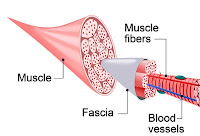Myofascial Restrictions: Just What Are They?
Fascia. We all have it. But what is it exactly?
 Fascia refers to connective tissue that interweaves our bones, muscles, nerves, and cardiovascular system. It supports structures and helps them connect to one another. Due to use of our bodies, however, it is not uncommon for the fascia in our systems to become adhered and cause our muscles to "stick," leading to a decrease in our range of motion and the possibility
Fascia refers to connective tissue that interweaves our bones, muscles, nerves, and cardiovascular system. It supports structures and helps them connect to one another. Due to use of our bodies, however, it is not uncommon for the fascia in our systems to become adhered and cause our muscles to "stick," leading to a decrease in our range of motion and the possibility
of pain. These adhesions are commonly referred to as myofascial restrictions.
Over time if the myofascial restrictions are allowed to stay in place our bodies will compensate for those restrictions by adjusting our posture, calling on some of our muscle groups to do more than their traditional job. This can cause secondary issues if not addressed.
Removing myofascial restrictions can be done through manual manipulations: massage, foam rolling, scraping, and cupping are some common techniques for this. Keep in mind that myofascial release does not feel the greatest. It can cause a local burning sensation where the technique is being done and should always be done within a tolerable level of pressure.
Corinne D. Bracko-Douglas, CMT, LMT, CKTP is the owner of Dochas Clinical Massage Therapy based out of Columbia, MO. She received her diploma in Clinical Massage Therapy from The Soma Institute in Chicago, IL in 2004. She enjoys teaching others about how to live a healthy lifestyle and still works one on one with clients out of her private clinic. When not working as a therapist she can be found enjoying trail hikes with her wonderful husband, Lee, and their adorable doggos, Shadow and Koda, or trying out fun new workouts to expand her knowledge of the human body and how it functions.
The advice given in these articles is not meant to diagnose. Please always consult with a health care provider before performing any of the techniques described upon yourself.
 Fascia refers to connective tissue that interweaves our bones, muscles, nerves, and cardiovascular system. It supports structures and helps them connect to one another. Due to use of our bodies, however, it is not uncommon for the fascia in our systems to become adhered and cause our muscles to "stick," leading to a decrease in our range of motion and the possibility
Fascia refers to connective tissue that interweaves our bones, muscles, nerves, and cardiovascular system. It supports structures and helps them connect to one another. Due to use of our bodies, however, it is not uncommon for the fascia in our systems to become adhered and cause our muscles to "stick," leading to a decrease in our range of motion and the possibilityof pain. These adhesions are commonly referred to as myofascial restrictions.
Over time if the myofascial restrictions are allowed to stay in place our bodies will compensate for those restrictions by adjusting our posture, calling on some of our muscle groups to do more than their traditional job. This can cause secondary issues if not addressed.
Removing myofascial restrictions can be done through manual manipulations: massage, foam rolling, scraping, and cupping are some common techniques for this. Keep in mind that myofascial release does not feel the greatest. It can cause a local burning sensation where the technique is being done and should always be done within a tolerable level of pressure.
Corinne D. Bracko-Douglas, CMT, LMT, CKTP is the owner of Dochas Clinical Massage Therapy based out of Columbia, MO. She received her diploma in Clinical Massage Therapy from The Soma Institute in Chicago, IL in 2004. She enjoys teaching others about how to live a healthy lifestyle and still works one on one with clients out of her private clinic. When not working as a therapist she can be found enjoying trail hikes with her wonderful husband, Lee, and their adorable doggos, Shadow and Koda, or trying out fun new workouts to expand her knowledge of the human body and how it functions.
The advice given in these articles is not meant to diagnose. Please always consult with a health care provider before performing any of the techniques described upon yourself.


Comments
Post a Comment